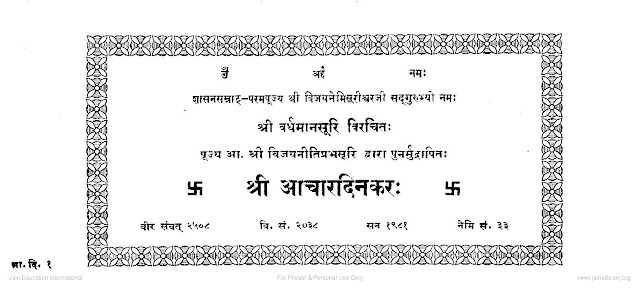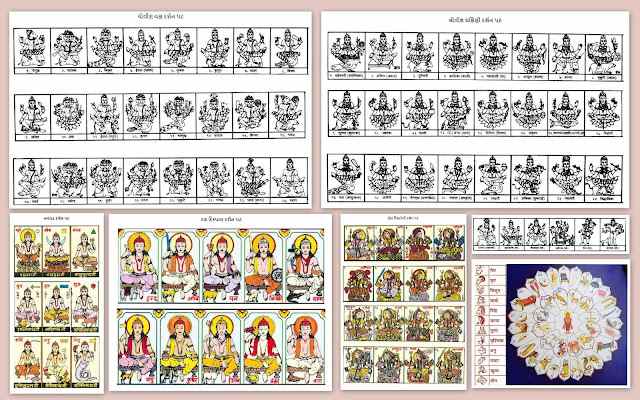What is the “Jain vidhi” for Marriage?
What is the “Jain vidhi” for Marriage? – To answer this question, we have to go back to the time of Lord Adinath, when humans were completely dependent on Kalpavruksh (“wish-fulfilling trees”) for their needs. Over time, gradual changes occurred and the yield of Kalpavruksh trees was reduced, leading to problems, disputes and disputes among the population.
To protect themselves from these disputes and live in peace and harmony, people formed groups led by a “Kulkar” (several people gathered to form a “Kul” and the leader of the group was called “Kulkar” , whose duty was to eliminate discord and establish order). This era of the Kulkar system came to be known as the period of the twins (Yugalik).
A human couple gave birth to a twin, a man and a woman. This twin would become husband and wife as an adult. The twins led happy and satisfied lives and died together of natural causes. King Nabhiraya of the Ikshawaku clan was the seventh and last of the Kulkar line. His wife was Queen Marudeva.
Lord Adinath was born to the seventh Kulkar, King Nabhiraya and Queen Marudevi. When the Lord was crowned king, he taught his people six major professions and 72 sciences that enabled his subjects to lead happy lives. This brings us to the chapter on the Lord’s marriage.
The institution of marriage was born after her marriage to Sunanda and Sumangala to set an example for other humans. Although Adinath Bhagwan’s twin was Sumangala, Lord also married Sunanda, when he saw that his twin had tragically passed away. It was the first marriage ever seen and the Lord Himself taught the universe the rituals to be followed in a marriage.
Kalikal Sarvagna Acharya Shri Hemchandracharya in his book Trishashtipurushshalaka Charitra mentions the details of the rituals that took place during the marriage of the Lord. Even Munishri Chirantanacharya’s work on Prakrit (translated as “Rushabh ni Shobha hu Shi Kahu”) mentions the magnificence – the first marriage in the universe – of Lord Adinath.
Do we have a religious text that provides explicit details on Jain Vidhi wedding rituals?
Over 1000 years ago, Acharyashri Vardhaman Surishwarji Maharaja made contemporary modifications to the wedding rituals displayed by Lord Adinath in the 10th century AD. in his work “Achar-Dinkar Granth ”. In the granth, Acharyashri establishes the rituals to be followed for 16 Sanskrit Grihastha Jeevan (sacraments of life) such as Garbhadhan Sanskaran Vidhi, Janam Sanskar Vidhi, Naamkaran Vidhi, Adhyayan Arambh Vidhi and Vivah Sanskar Vidhi, among others. All the rituals that must be followed for a marriage according to Jain beliefs find their place in article 14 of the granth.

jain marriage vidhi sacred text book
If the same thing has been mentioned in the scriptures, why do some Jains oppose this vidhi?
Some subsects of the Shwetambar Jains oppose this vidhi because they believe that materialistic rituals should not be performed in front of the Tirthankars. They are right up to a point, but they do not understand that the true rituals of marriage have no place in front of the idols of Jain Tirthankar; only the previous pujans are conducted in front of Arihant’s parmatma.
Achar Dinkar Granth does not advocate placing Tirthankar idols during marriage. Another opposition to Jain vidhi of marriage from some Acharya of Tapagach (a subsect) is that Acharya Vardhman Suri (who wrote Achar Dinkar) belonged to Rudrapalli Gacch and not Tapagach so they should not be followed; However, they do not understand that this granth was written before the birth of Tapacgacch or Khartargach for that matter and most of the other vidhis of this granth are accepted by all sects.
Why would anyone follow Jain Vidhi to get married?
Today, most Jains marry, as demonstrated by the Brahmin pundits. More than following rituals, weddings have become spectacles of pomp and fanfare. All the piety and sanctity of the rituals has been reduced to a sideline and people are more interested in the glamor and various exotic foods served to them at the weddings they attend. Being Jains, it is our most important duty to follow the teachings established by Tirthankar and the revered Acharya Bhagwant. Making offerings to Mithyatva Devi-Devta creates more karma-bandh.
It is also relevant to note that although the Shwetambar have for the most part ceased to follow the ‘Jain-Vidhi’, the Digambar’s tend to follow the Jain Vidhi in their marriage rituals (the rituals of Digambar Jain Vidhi are somewhat different from the Shwetambar. ).
How is a Jain marriage different from a normal marriage?
The biggest tangible differences that can be noticed in a Jain wedding are that no shoes are allowed at the wedding venue and no food of any kind is allowed during the entire process to maintain the sanctity of the rituals.
Although most of the rituals are similar to those of Gujarati weddings (Varmala, Hasta Melap, 4 Fera, etc.), the difference is that all offerings are made to Tirthankara and Devi-Devta according to Jain cosmology and not to the Hindu deities. Also, the holy chants are derived from Achar Dinkar Granth, which makes them completely different from other marriages.
Also, Jain Vidhi rituals include Pujan d’Arihant Parmatma, Sidhha Bhagwant, 45 Agam, Navgraha, Das Dikpal, 16 Vidya Devis, 24 Yaksha, 24 Yakshini, Kulkar, Ashtamatruka, 12 Rashi, 27 Nakshatra to consolidate the entire Jain cosmos. .
Does this mean that the marriage takes place before the Jain idols Tirthankara and the demigods / goddesses?
Rituals before Toran pratishtha must be performed before the idols of Tirthankar. Panigrahan vidhis and feras are not to be performed in front of the idols of Tirthankar. All the offerings are also made to Mangal Murti and not to the idols on which the Anjanshalakha was performed.
Also Read : Muktagiri Jain Temple – Bhagwan Shantinath ji Mandir
Overview of the rituals that take place according to Jain Vidhi.
Following are the major rituals that take place in the Jain-Vidhi of Marriage-
Sthapana Vidhi- After a Namaskar Mahamantra song, all the Lord’s idols are ceremoniously installed at the place of marriage.
Atma Raksha- Protection of soul from unholy elements.
Mantra Snan – Purification of the soul by Sacred Chants.
Kshetrapal Pujan- Seeking permission and paying homage to the Kshetrapal Dev of the land
Mindhon Bandhan – Tying the sacred thread in the hands of the bride and groom
Arhat Pujan- Pujan of Arihant Parmatma
Siddha Pujan – Pujan of all Siddha Bhagwant’s
Gandhar Pujan – Pujan of all Gandhar Bhagwant’s
Shastra Pujan – Pujan of 45 Agams
Chovis Yaksha- Yakshini Pujan – Pujans of 24 Demi Gods and Goddesses of Tirthankaras
Dash Digpal Pujan – Pujan of Guardians of Directions
Solash Vidyadevi Pujan- Pujan of 16 Demi-Goddesses of Learning
Baar Rashi Pujan – Pujan of Astronomical Signs
Nav Grah Pujan – Pujan of 9 Sacred Planets
Satyavish Nakshatra Pujan – Pujan of 27 Pious Constellations
Toran Pratishtha – Installation of a Toran prepared from the leaves of the ‘Ashoka’ tree
Vedi Pratishtha – Vedka installation where the wedding rituals take place
Panigrahan (Hastamelap) – The bride’s parents hand over their daughter to the groom putting the the bride’s right hand on the groom’s right hand as she recites sacred verses for stability and
longevity of her married life.
Pradakshina – The couple surrounds the fire four times in a clockwise direction, representing the sacred direction of life. Each bypass represents the four fundamental goals of humanity: Dharm, Arth, Karm and Moksh.
Abhisinchan Vidhi – Instead of Sindoor, the groom blesses the bride with Tirth-Jal (water from holy rivers/ tirth’s)
Saat Pratigna – The couple make seven vows to strengthen their married life. The wishes are pronounced in 7 betel nuts that represent sustenance, strength, wealth, knowledge, children, health and love.
Arti- Mangal Dipak
Kshama Yachna – Seeking forgiveness for mistakes.
Other Ashtamatruka and Kulkar pujans take place a few days before the wedding at the bride’s residence and the groom’s residence, respectively.
Also Read : The Jain Maha – tirth of Malwa Mohankheda
Can a Pandit perform the rituals according to Jain Vidhi?
No. Only a Vidhikaar who has extensive knowledge of Aachar Dinkar Granth can perform a wedding according to Jain Rituals.
Do the bride and groom have to fast on their wedding day?
It is always recommended that a pious ritual be accompanied by any Tapasya. Therefore, the bride and groom should do Ayambil followed by Paushadh on their wedding day. You can also do any other Tapasya (Upwas, Ekashna, Beyashna). However, if this is not possible, the bride and groom should at least do Navkarsi and Choviar and practice Brahmacharya on the wedding day.
Is it possible to add another habitual vidhi to the Jain Vidhi of marriage?
Vidhi such as Varbediyu (greeting the bride’s sister’s groom) and Pokhna (greeting the bride’s mother’s groom) that do not cause any ashatana to Arihant Parmatma can be added with the permission of Vidhikaar.
Weddings should be full of fun! How to enjoy a marriage that looks more like a Pujan?
More than fun, it is important to start a new chapter in life with divine holiness and rituals. However, Jain weddings can be fun too! The rituals are very intriguing and the addition of music makes the wedding magical. The Vidhikaar is responsible for explaining the rituals so that everyone can soak up!
I wanna Thank Arpit Shah ji for his great work and research on jain marriage and his article helped a lot to form this article into existence.
Please do read his articles and do visit his website too : www.storiesbyarpit.com
Also Read : 63 Shalaka Purush – Heroes or Great persons

